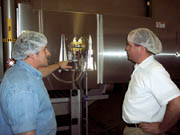
Detroit's Karpe family began roasting nuts in 1933 in the shadow of Navin Field, where the Detroit Tigers once played. When the family matriarch retired in 1967, Bud Nicolay purchased Kar's Nuts, which had abandoned the Karpe kitchen 20 years earlier to roast and package nuts in Ferndale, MI.
The facility grew piecemeal over the years, at one point acquiring two oil roasters that haven't been state-of-the-art since the mid-twentieth century. Nicolay sold the business to his son, Nick, in 1995. Since then, sales have tripled, and marketing success aggravated manufacturing deficiencies. Ownership knew a facility overhaul or replacement was a matter of when, not if.
Last April, the company closed the deal on its new crown jewel: a 131,000-sq.-ft. building in Madison Heights, MI. Years of research preceded the purchase, a prerequisite if an ambitious fast-track schedule was to be met: gut and rebuild the interior of a former steel fabrication plant to meet food production standards, engineer a process flow with virtually all new equipment, and commence production less than eight months after the ink had dried on the real-estate contract. Further complicating the task was a decision to rely on equipment suppliers for process engineering expertise and management's ability to guide a general contractor and an architect with no previous food construction experience on the needs of a food-grade facility.
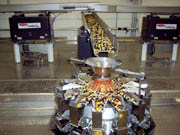
All they can be
The five-mile journey to Madison Heights really began when Nick Nicolay hired Vice President Bill Elam in 1994 to help reshape the company and allow Kar's Nuts to realize its potential. The two men have more than doubled the number of direct store delivery (DSD) routes from 29 to almost 70, expanding distribution into Ohio, Indiana and Illinois. The company also has become the second largest national supplier of packaged nuts to the vending distribution channel. In the new millennium, the company began selling to club store retailers. With sales booming, manufacturing issues became glaring problems.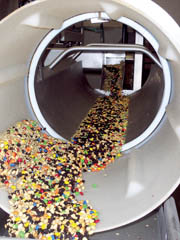
Before management abandoned plans to expand the old plant, key personnel were visiting pilot plants and evaluating the latest fryer technology to determine if it could improve the quality of the roast. Commercial roasters typically convey product through a shallow pan of oil, similar to a donut fryer. Fines often remain in the oil and hasten degradation, and free fatty acids released by nuts produce uneven roasting, resulting in frequent replacement of the oil. Heat and Control Inc. developed a system that relies on a series of weirs to create thin curtains of oil. The oil cascades over the product, then is recirculated through a filtering system before returning to the roaster. The technology was developed to provide gentle frying of breaded fish, chicken and other high-margin products. "It was almost accidental that it was applied to nuts," Heat and Control's Mike Macbeth says.
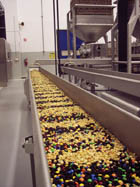
"The one surprise was how big they were," recalls Elam. "We had installed a 10-ft. high door to the roasting room. The new machines had 1.5-in. clearance."
Operators formerly replenished oil from drums. In the new plant, an adjoining room houses an 8,000-gallon oil storage tank fabricated by Shick USA and integrated with the fryer. It was one of the more straightforward controls interfaces in the project. "The roaster basically sends out a ‘we need oil' or ‘sending oil back' signal to the tank," according to systems integrator Kevin Orr, vice president-engineering for Process Solutions Inc. (PSI). Kar's roasters recirculate 370 gallons of oil a minute; to help extend the oil's useful life, a second oil filter was installed. Peanut oil prices doubled in recent years, Elam notes, which helped justify double filtration. Managers are monitoring the system to determine if it meets the fabricator's estimate of a 40 percent savings in oil use.
Controls integration became more complex in the next phase of production. Roasted nuts are transferred in 1,200-lb. totes to the adjoining mixing room. In the old plant, ingredients were mixed on a vibratory conveyor, a noisy machine that required constant adjustment. At times, hand mixing augmented the belt to help meet production schedules. An ingredient that should compose a quarter of a package's weight might be 5 to 9 points above or below that target weight. In the new mixing room, weigh belts consistently deliver ingredients that are within 0.5 percent of the target, according to Production Manager Matt Spence, and the gentle handling by horizontal motion conveyors means minimal residue from coatings and virtually no product damage.
Integration was complicated by multiple vendors: K-Tron supplied the seven weigh belts, each of which can process 10,000 lbs. of product an hour, while Heat and Control made the 45 horizontal motion conveyors that move product through the mixing room and into packaging. "We challenged them to take ownership of the whole system," Elam says. "When we turn the switch, if it doesn't work, it's their responsibility."
Both PSI and Heat and Control accepted the challenge. Leading the engineering team was Jonny Fitzgerald from Heat and Control's product handling division in Carrollton, TX. Fitzgerald also is a co-developer of a tumble drum introduced last year and in use at the Kar's Nuts plant. Snack food processors often rely on seasoning systems to ensure a complete mix of ingredients, Fitzgerald explains, but those systems are bulky and expensive. The mixing tumbler does the job for half the price and with a much smaller footprint.
Fitzgerald designed Kar's distribution system from mixing to packaging and coordinated with PSI on controls integration. "We started with a blank sheet and worked back from the scales, beginning with the minimum distance needed and then devising a system that can always mix more than can be packaged," he says. Adds PSI's Orr: "We probably were on the phone daily with Jonny and the other people in Carrollton to ensure a seamless integration."
Elevators lift mixed product 15 ft. from the floor of the mixing room to a platform in the adjacent packaging room. Throughput rates and product density allowed Fitzgerald to use 6-in. wide conveyor pans to feed product through a network of conveyors to the digital weigh scales. Buckets on the scales are cleaned and sanitized in a Douglas washing unit on a separate platform abutting the scale platform. Vibration from the washer would compromise the accuracy of the scales' load cells if they shared a common platform, explains Elam. The wash cabinet replaced a manual protocol for scale-bucket cleaning that took an hour and turned it into a 10-minute automated function. Sanitation also was improved with CIP systems for the roasters and elevator conveyors.
The form/fill/seal machines account for most of the equipment that made the move from the old plant. Another is the Domnick Hunter nitrogen generator the company purchased two years ago. Like many snack food companies, Kar's Nuts has eliminated purchases of liquid nitrogen in favor of generators coupled with air compressors that can supply a limitless source of nitrogen for packaging. Spence estimates the payback on the system at less than 12 months.
The packaging area also features five automated case-packing machines custom built for Kar's Nuts. A lower cost, faster alternative to robotic equipment, the machines receive packages from simple and twin-tube form/fill/seal machines. After allowing the programmed number of packages into a case, they accumulate product until a new box is in place. "I envisioned this kind of machine seven or eight years ago, but I couldn't find anyone who could build it," Elam relates. He worked with local engineers at Inspired Packaging and Tuff Automation Inc. in Grand Rapids, MI, to build a prototype machine. It performed as expected in the old facility and four more were built for the new plant.
Elam will tap Tuff for more automation later this year to convey filled boxes to a bar code reader, metal detector and a palletizer for shrink wrapping.
Unpolished gem
Creating a space consistent with contemporary food processing standards was a collaborative effort between management and local contractor Kemp Building & Development Co. The building was little more than an unheated shell when Kar's Nuts bought it. Steel girders hovered 37 ft. above a rough concrete floor, with massive steel supports for industrial cranes just below them. All interior walls were gutted and replaced.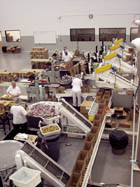
They carved out a 300-by-240-ft. work area, leaving an unused 34,000-sq.-ft. space for leasing and future expansion. A drop ceiling reduces the cube's height to 32 ft., still a tax on the HVAC system but an advantage in the warehouse area, where racks to accommodate five-high pallets are installed. DSD drivers distribute beef jerky and other snack items besides the company's own, and accommodating an expanded inventory won't be an issue.
Bright metal-halide lighting was a priority to take the guesswork out of evaluating the color of roasted nuts. The same painstaking research that went into equipment selection was applied to fit-and-finish issues like flooring. After visiting plants with 15-year-old floors, managers opted for slip-resistant, epoxy-covered floors from Stonehard. A blower from Spencer Turbine Co. powers a central vacuum system that runs throughout the plant. Sanitation crews formerly used forced air to clean packaging machines and conveyors; vacuum does the job without raising dust, delivering a significant hygiene upgrade.
Cleaner air and quieter conveyors also produce a more favorable environment for the plant's 100 workers. Appointments such as the gas stove in the lunchroom, an enclosed outdoor picnic area and a TV area are additional amenities. Key cards control the two building entries.
To showcase the improvements, a glass-enclosed corridor was built to give customers and visitors a close-up view of the processing, mixing and packaging rooms. "Building an observation hallway originally was one of our luxuries," Elam says. "After a while, we saw it as a necessity."
Though the project was completed under budget, the $14.9 million total cost represents a significant investment for a company with sales of approximately $45 million. And while more product innovation is likely in the new facility, future sales are contingent on public perceptions of the nut, a food type vulnerable to the ups of protein-rich diets and the downs of allergen concerns.
Ownership is betting the house on a favorable outcome, putting its own capital and the well being of the families of 160 employees on the line. It's a wager that makes a big stakes Texas Hold ‘em tournament look like kid's stuff. Helping to shorten the odds of success is a manufacturing team with a solid track record and, thanks to the new facility, a strong hand to play.
For more information:
Jim Tomczyk, Domnick Hunter Ltd.,
630-238-1375
Jonny Fitzgerald, Heat and Control,
972-488-9285,
jonnyf@heatandcontrol.com
Mike Macbeth, Heat and Control,
717-566-5820
Kevin Orr, Process Solutions Inc.,
360-403-7037